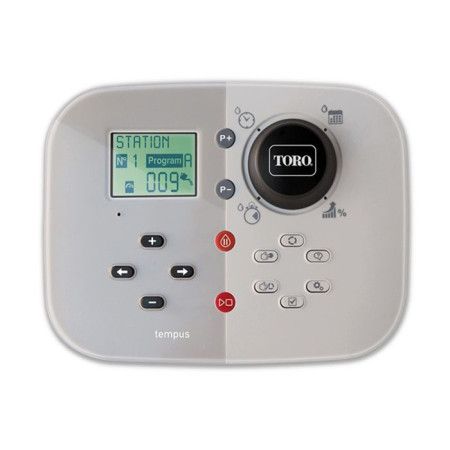Tempus - Control unit with 4 stations for internal use
Programmer control unit for indoor irrigation with 4 stations.


Toro's innovative new TEMPUS® Series controller is designed to help residential customers save time and help them manage their water resources.
Water-saving features, flexible irrigation scheduling, optional local Wi-Fi accessibility and easy app programming, all at your fingertips to help you stay in control of your garden.
The sleek new design, low profile and compact size integrate seamlessly into the home environment for convenient access.
The same programming module is suitable for all versions of internal, external, basic or intermediate models.
Easy to program. Installation and future maintenance are quick and easy with a large LCD display and an intuitive interface. The multilingual display can be set to one of 5 languages. You can select English, Spanish, French, German or Italian.
Local Wi-Fi ready. The optional Wi-Fi module allows remote monitoring and access of the controller from anywhere within the range of your home wireless network device and can be controlled remotely with a smartphone.
Dental chair programming, after recharging, allows you to remove the controller from the wall support to set the irrigation program.
The Water Management function allows you to increase the active time of all stations assigned to a specific program from 0% to 200% in 10% increments.
2 independent programs and 3 start times running simultaneously with start time overlap protection for each program.
- Number of zones
- 4
- Valves by sector
- 1
- Number of departures
- 3
- Number of programs
- 2
- Output voltage (Volt)
- 24 VAC
- LCD display
- Yes
- Wifi
- option
- Non-volatile memory
- Yes
- Remote control
- Yes
- Modular
- no
- Watertight
- no
- Assembly
- indoor
- Compatible with rain sensor
- Yes
- Backup battery
- no
- Supply
- mains voltage
- Overcurrent protection
- Yes
- Height (cm)
- 14
- Width (cm)
- 18.6
- Depth (cm)
- 6.7
- Guarantee
- Two years
- Simultaneous programs
- no
- Odd and even day programming
- Yes
- Weekly programming
- Yes














